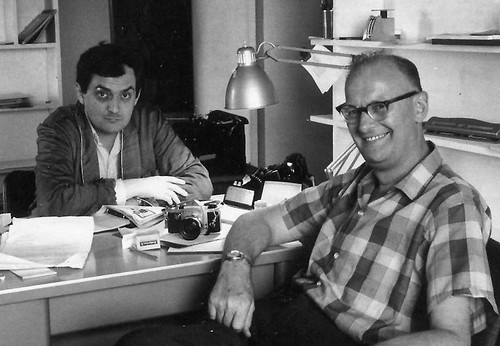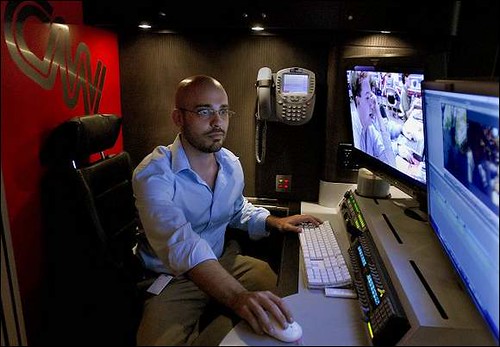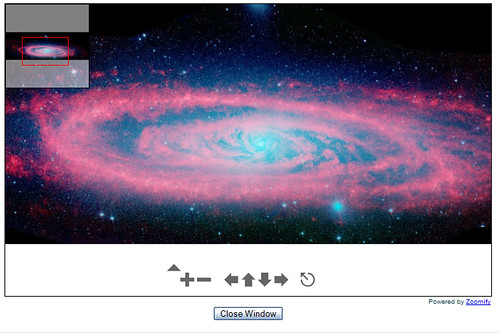“How I Lost a Billion Dollars in My Spare Time”
Tuesday, March 18th, 2008Typically well done obituary in Wednesday’s New York Times:
Arthur C. Clarke, Premier Science Fiction Writer, Dies at 90
By GERALD JONAS
Published: March 19, 2008
Arthur C. Clarke, a writer whose seamless blend of scientific expertise and poetic imagination helped usher in the space age, died early Wednesday in Colombo, Sri Lanka, where he had lived since 1956. He was 90.
Rohan de Silva, an aide, confirmed the death and said Mr. Clarke had been experiencing breathing problems, The Associated Press reported. He had suffered from post-polio syndrome for the last two decades.
The author of almost 100 books, Mr. Clarke was an ardent promoter of the idea that humanity’s destiny lay beyond the confines of Earth. It was a vision served most vividly by “2001: A Space Odyssey,” the classic 1968 science-fiction film he created with the director Stanley Kubrick and the novel of the same title that he wrote as part of the project.
His work was also prophetic: his detailed forecast of telecommunications satellites in 1945 came more than a decade before the first orbital rocket flight.
Other early advocates of a space program argued that it would pay for itself by jump-starting new technology. Mr. Clarke set his sights higher. Borrowing a phrase from William James, he suggested that exploring the solar system could serve as the “moral equivalent of war,” giving an outlet to energies that might otherwise lead to nuclear holocaust.
Mr. Clarke’s influence on public attitudes toward space was acknowledged by American astronauts and Russian cosmonauts, by scientists like the astronomer Carl Sagan and by movie and television producers. Gene Roddenberry credited Mr. Clarke’s writings with giving him courage to pursue his “Star Trek” project in the face of indifference, even ridicule, from television executives.
In his later years, after settling in Ceylon (now Sri Lanka), Mr. Clarke continued to bask in worldwide acclaim as both a scientific sage and the pre-eminent science fiction writer of the 20th century. In 1998, he was knighted by Queen Elizabeth II.
Mr. Clarke played down his success in foretelling a globe-spanning network of communications satellites. “No one can predict the future,” he always maintained. But as a science fiction writer he couldn’t resist drawing up timelines for what he called “possible futures.” Far from displaying uncanny prescience, these conjectures mainly demonstrated his lifelong, and often disappointed, optimism about the peaceful uses of technology — from his calculation in 1945 that atomic-fueled rockets could be no more than 20 years away to his conviction in 1999 that “clean, safe power” from “cold fusion” would be commercially available in the first years of the new millennium.
Popularizer of Science
Mr. Clarke was well aware of the importance of his role as science spokesman to the general population: “Most technological achievements were preceded by people writing and imagining them,” he noted. “I’m sure we would not have had men on the Moon,” he added, if it had not been for H. G. Wells and Jules Verne. “I’m rather proud of the fact that I know several astronauts who became astronauts through reading my books.”
Arthur Charles Clarke was born on Dec. 16, 1917, in the seaside town of Minehead, Somerset, England. His father was a farmer; his mother a post office telegrapher. The eldest of four children, he was educated as a scholarship student at a secondary school in the nearby town of Taunton. He remembered a number of incidents in early childhood that awakened his scientific imagination: exploratory rambles along the Somerset shoreline, with its “wonderland of rock pools”; a card from a pack of cigarettes that his father showed him, with a picture of a dinosaur; the gift of a Meccano set, a British construction toy similar to American Erector Sets.
He also spent time, he said, “mapping the moon” through a telescope he constructed himself out of “a cardboard tube and a couple of lenses.” But the formative event of his childhood was his discovery, at age 13 — the year his father died — of a copy of Astounding Stories of Super-Science, then the leading American science fiction magazine. He found its mix of boyish adventure and far-out (sometimes bogus) science intoxicating.
While still in school, he joined the newly formed British Interplanetary Society, a small band of sci-fi enthusiasts who held the controversial view that space travel was not only possible but could be achieved in the not-so-distant future. In 1937, a year after he moved to London to take a civil service job, he began writing his first science fiction novel, a story of the far, far future that was later published as “Against the Fall of Night” (1953).
Mr. Clarke spent World War II as an officer in the Royal Air Force. In 1943 he was assigned to work with a team of American scientist-engineers who had developed the first radar-controlled system for landing airplanes in bad weather. That experience led to Mr. Clarke’s only non-science fiction novel, “Glide Path” (1963). More important, it led in 1945 to a technical paper, published in the British journal Wireless World, establishing the feasibility of artificial satellites as relay stations for Earth-based communications.
The meat of the paper was a series of diagrams and equations showing that “space stations” parked in a circular orbit roughly 22,240 miles above the equator would exactly match the Earth’s rotation period of 24 hours. In such an orbit, a satellite would remain above the same spot on the ground, providing a “stationary” target for transmitted signals, which could then be retransmitted to wide swaths of territory below. This so-called geostationary orbit has been officially designated the Clarke Orbit by the International Astronomical Union.
Decades later, Mr. Clarke called his Wireless World paper “the most important thing I ever wrote.” In a wry piece entitled, “A Short Pre-History of Comsats, Or: How I Lost a Billion Dollars in My Spare Time,” he claimed that a lawyer had dissuaded him from applying for a patent. The lawyer, he said, thought the notion of relaying signals from space was too far-fetched to be taken seriously.
But Mr. Clarke also acknowledged that nothing in his paper — from the notion of artificial satellites to the mathematics of the geostationary orbit — was new. His chief contribution was to clarify and publicize an idea whose time had almost come: it was a feat of consciousness-raising of the kind he would continue to excel at throughout his career.
A Fiction Career Is Born
The year 1945 also saw the start of Mr. Clarke’s career as a fiction writer. He sold a short story called “Rescue Party” to the same magazine — now re-titled Astounding Science Fiction — that had captured his imagination 15 years earlier.
For the next two years Mr. Clarke attended King’s College, London, on the British equivalent of a G.I. Bill scholarship, graduating in 1948 with first-class honors in physics and mathematics. But he continued to write and sell stories, and after a stint as assistant editor at the scientific journal Physics Abstracts, he decided he could support himself as a free-lance writer. Success came quickly. His primer on space flight, “The Exploration of Space,” became an American Book-of-the-Month Club selection.
Over the next two decades he wrote a series of nonfiction bestsellers as well as his best-known novels, including “Childhood’s End” (1953) and “2001: A Space Odyssey” (1968). For a scientifically trained writer whose optimism about technology seemed boundless, Mr. Clarke delighted in confronting his characters with obstacles they could not overcome without help from forces beyond their comprehension.
In “Childhood’s End,” a race of aliens who happen to look like devils imposes peace on an Earth torn by Cold War tensions. But the aliens’ real mission is to prepare humanity for the next stage of evolution. In an ending that is both heartbreakingly poignant and literally earth-shattering, Mr. Clarke suggests that mankind can escape its suicidal tendencies only by ceasing to be human.
“There was nothing left of Earth,” he wrote. “It had nourished them, through the fierce moments of their inconceivable metamorphosis, as the food stored in a grain of wheat feeds the infant plant while it climbs towards the Sun.”
The Cold War also forms the backdrop for “2001.” Its genesis was a short story called “The Sentinel,” first published in a science fiction magazine in 1951. It tells of an alien artifact found on the Moon, a little crystalline pyramid that explorers from Earth destroy while trying to open. One explorer realizes that the artifact was a kind of fail-safe beacon; in silencing it, human beings have signaled their existence to its far-off creators.
Enter Stanley Kubrick
In the spring of 1964, Stanley Kubrick, fresh from his triumph with “Dr. Strangelove or: How I Learned to Stop Worrying and Love the Bomb,” met Mr. Clarke in New York, and the two agreed to make the “proverbial really good science fiction movie” based on “The Sentinel.” This led to a four-year collaboration; Mr. Clarke wrote the novel and Mr. Kubrick produced and directed the film; they are jointly credited with the screenplay.
Many reviewers were puzzled by the film, especially the final scene in which an astronaut who has been transformed by aliens returns to orbit the Earth as a “Star-Child.” In the book he demonstrates his new-found powers by detonating from space the entire arsenal of Soviet and United States nuclear weapons. Like much of the plot, this denouement is not clear in the film, from which Mr. Kubrick cut most of the expository material.
As a fiction writer, Mr. Clarke was often criticized for failing to create fully realized characters. HAL, the mutinous computer in “2001,” is probably his most “human” creation: a self-satisfied know-it-all with a touching but misguided faith in his own infallibility.
If Mr. Clarke’s heroes are less than memorable, it’s also true that there are no out-and-out villains in his work; his characters are generally too busy struggling to make sense of an implacable universe to engage in petty schemes of dominance or revenge.
Mr. Clarke’s own relationship with machines was somewhat ambivalent. Although he held a driver’s license as a young man, he never drove a car. Yet he stayed in touch with the rest of the world from his home in Sri Lanka through an ever-expanding collection of up-to-date computers and communications accessories. And until his health declined, he was an expert scuba diver in the waters around Sri Lanka.
He first became interested in diving in the early 1950s, when he realized that he could find underwater, he said, something very close to the weightlessness of outer space. He settled permanently in Colombo, the capital of what was then Ceylon, in 1956. With a partner, he established a guided diving service for tourists and wrote vividly about his diving experiences in a number of books, beginning with “The Coast of Coral” (1956).
Of his scores of books, some like “Childhood’s End,” have been in print continuously. His works have been translated into some 40 languages, and worldwide sales have been estimated at more than $25 million.
In 1962 he suffered a severe attack of polio. His apparently complete recovery was marked by a return to top form at his favorite sport, table tennis. But in 1984 he developed post-polio syndrome, a progressive condition characterized by muscle weakness and extreme fatigue. He spent the last years of his life in a wheelchair.
Clarke’s Three Laws
Among his legacies are Clarke’s Three Laws, provocative observations on science, science fiction and society that were published in his “Profiles of the Future” (1962):
¶“When a distinguished but elderly scientist states that something is possible, he is almost certainly right. When he states that something is impossible, he is very probably wrong.”
¶“The only way of discovering the limits of the possible is to venture a little way past them into the impossible.”
¶“Any sufficiently advanced technology is indistinguishable from magic.”
Along with Verne and Wells, Mr. Clarke said his greatest influences as a writer were Lord Dunsany, a British fantasist noted for his lyrical, if sometimes overblown, prose; Olaf Stapledon, a British philosopher who wrote vast speculative narratives that projected human evolution to the farthest reaches of space and time; and Herman Melville’s “Moby-Dick.”
While sharing his passions for space and the sea with a worldwide readership, Mr. Clarke kept his emotional life private. He was briefly married in 1953 to an American diving enthusiast named Marilyn Mayfield; they separated after a few months and were divorced in 1964, having had no children.
One of his closest relationships was with Leslie Ekanayake, a fellow diver in Sri Lanka, who died in a motorcycle accident in 1977. Mr. Clarke shared his home in Colombo with his friend’s brother, Hector, his partner in the diving business; Hector’s wife, Valerie; and their three daughters.
Mr. Clarke reveled in his fame. One whole room in his house — which he referred to as the Ego Chamber — was filled with photos and other memorabilia of his career, including pictures of him with Yuri Gagarin, the first man in space, and Neil Armstrong, the first man to walk on the moon.
Mr. Clarke’s reputation as a prophet of the space age rests on more than a few accurate predictions. His visions helped bring about the future he longed to see. His contributions to the space program were lauded by Charles Kohlhase, who planned NASA’s Cassini mission to Saturn and who said of Mr. Clarke, “When you dream what is possible, and add a knowledge of physics, you make it happen.”
At the time of his death he was working on another novel, “The Last Theorem,” Agence France-Presse reported. “ The Last Theorem’ has taken a lot longer than I expected,” the agency quoted him as saying. “That could well be my last novel, but then I’ve said that before.”
On to the next dimension, Sir Arthur.












